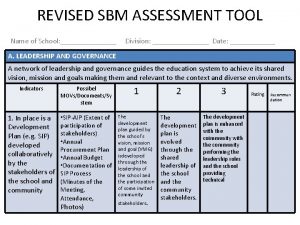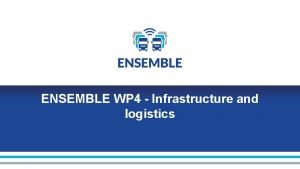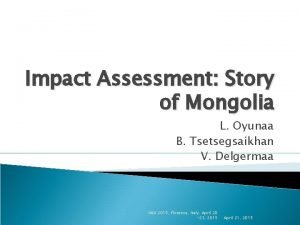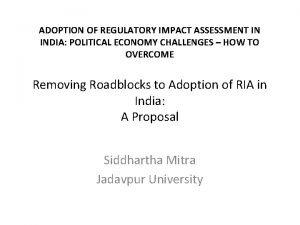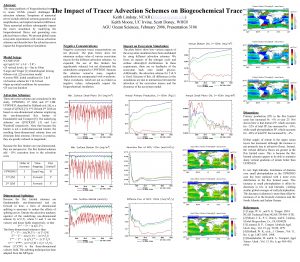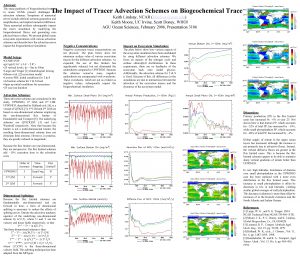Tracer Study Impact Assessment of four CHIETA programmes
























- Slides: 24


Tracer Study: Impact Assessment of four CHIETA programmes (Project in progress)

Purpose / objective of study • To determine the impact of the CHIETA learnership, apprenticeship, and workintegrated learning (WIL) programmes in the lives of beneficiaries who completed their training during the 2017/2018 period • To determine the value of the training voucher project in terms of advancing the knowledge and skills of SMME owners and co-workers

Background • Applying the impact assessment model that was developed in 2017 on work-based learning (WBL) programmes • Defining WBL • Apprenticeships • Learnerships • Work-integrated learning (WIL) • WIL in the CHIETA context • Internships • TVET college qualifications • Higher Education Institution (HEI) qualifications

Research Methodology (1) • Both quantitative and qualitative methods are applied to collect data – Tracer study by means of cross-sectional surveys using structured interviews (beneficiaries of apprenticeships, learnerships, and WIL programmes) – Semi-structured interviews (employers and owners of SMMEs) – Case studies in video format (success stories of beneficiaries)

Research Methodology (2) • Samples for apprenticeship and learnership surveys stratified according to: – Type of learner (18. 1 or 18. 2) (proportional) – Type of trade/learnership (proportional) – Gender (disproportional) – Random sample was drawn from each group • Complete sample framework used for WIL participants – lack of contact details • Purposive samples for – Employers (15) – SMMEs (10) – Case studies (5)

Realisation of Survey Samples Programmes Apprenticeships (Survey completed) Learnerships (Survey completed) WIL (In progress) Total Year 2017/2018 Sample Framework (N) Realisation of Sample (%) Q 1 -Q 3 472 210 44 Q 1 -Q 4 697 297 43 Q 2 124 36 29 1 293 543 42

Demographic profile of apprenticeship respondents (N=210) N % Unemployed (18. 2) 142 68 Employed (18. 1) 68 32 Male 186 89 Female 24 11 African 176 84 Coloured 8 4 Indian 8 4 White 18 9 Automotive Motor Mechanic 2 1 Electrician 80 38 Fitter and Turner 4 2 Instrument Mechanician 6 3 Mechanical Fitter 31 15 Rigger 62 30 Welder 25 12 Average 34

Demographic profile of learnership respondents (N=297) N % Unemployed (18. 2) 221 74 Employed (18. 1) 76 26 Male 198 67 Female 99 33 African 264 89 Coloured 14 5 Indian 11 4 White 8 3 Automated Packaging Operator 37 12 Boiler Maker 12 4 Chemical Manufacturing 78 26 Chemical Operations 49 16 Electrical Engineering 30 10 Electrician 1 0 Instrument Mechanician 1 0 Measurement, Control & Instrumentation 13 4 Mechanical Fitter 42 14 Molten Glass Production 2 1 Pharmaceutical Sales Representation 16 5 Rigger 3 1 Welder 13 4 Average 31

Employment of Unemployed (18. 2) learners after completion of learning programme Learnerships (N=229) Employed after training 64% Still unemployed after training 36% Apprenticeships (N=142) Employed after training 50% Still unemployed after training 50%

Employment of 18. 2 learners who completed learnerships Self-employed 1% Employed by the same company 72% Employed by another company 27%

Employment conditions (learnerships) • Full-time (40 hours or more per week) – 87% • Permanent position – 75%

Income levels (gross p. m. ) of 18. 2 learners who are employed (learnerships) >R 20 000 <R 5 000 9% 10% R 15 000 - R 20 000 23% R 5 000 - R 9 999 22% R 10 000 - R 14 999 36%

Employed 18. 2 learners (learnerships) Different type of work not in the chemical sector 7% Different type of work in the chemical sector 3% Same type of work not in the chemical sector 16% Same type of work in the chemical sector 74%

Employed 18. 2 learners (apprenticeships) Selfemployed 7% (N=5) Employed by the same company 57% Employed by another company 36%

Employment conditions (apprenticeships) • Full-time (40 hours or more per week) – 86% • Permanent position – 62%

Income levels (gross p. m. ) of 18. 2 learners who are employed (artisans) <Less R 5 000 9% >R 20 000 18% R 15 000 - R 20 000 13% R 10 000 - R 14 999 24% R 5 000 - R 9 999 36%

Employed 18. 2 learners (artisans) Different type of work not in the chemical sector 3% Different type of work in the chemical sector 7% Same type of work not the chemical sector 24% Same type of work in the chemical sector 66%

Unemployed artisans (N=82) Welder 15% Electrician 21% Instrument Mechanician 1% Rigger 48% Mechanical Fitter 16%

Unemployed (18. 2) learners who could not get access to employment (artisans) Reason for unemployment Number of times mentioned % No jobs available / economy 68 51 Lack of experience 26 19 Over supply 16 12 Only small contracts available 6 4 Corruption 5 4 Gender discrimination (male dominated) 4 3 Health issues 2 1 Relocation necessary 2 1 Still waiting on contract 2 1 Further studying 2 1 Strikes 1 1 134 100 Total

Unemployed (18. 2) learners who could not get access to employment (learnerships) Reason for unemployment No jobs available / economy Lack of experience Need further training Corruption Over supply Family responsibilities Need to do trade test Waiting for trade test certificate Studying full-time Insufficient contacts / networks Only small contracts available Waiting for learnership certificate Insufficient contacts / networks Foreigners take opportunities away Health issues Total Number of times mentioned 67 44 12 8 6 4 3 4 6 2 1 1 161 % 42 27 7 5 4 2 2 2 4 1 1 1 100

Case studies 1. Bafana Mahlangu – RPL to qualified Boilermaker (Richards Bay) 2. Nompumelelo Mbutho – Chemical Operations learnership (Amanzimtoti)

Preliminary recommendations • Further investigate and address the reasons why some artisans struggle to find employment • Establish a relationship with an intermediary that can assist with the placement of unemployed learners who struggle to find employment after completion of a learning programme • Further support SMMEs in terms of entrepreneurial training • Include entrepreneurial training in all programmes

Follow us on your favourite Social Media platform @chietasa @chieta_sa @chietasa
 Chieta trade test
Chieta trade test Chieta login
Chieta login Chieta login
Chieta login Chieta bursary
Chieta bursary Tracer study tool sbm
Tracer study tool sbm Tracer study conceptual framework
Tracer study conceptual framework Environmental impact assessment ktu syllabus
Environmental impact assessment ktu syllabus Business impact analysis vs risk assessment
Business impact analysis vs risk assessment Experience assessment
Experience assessment Rapid environmental impact assessment in disaster
Rapid environmental impact assessment in disaster Traffic impact assessment
Traffic impact assessment Change impact assessment template
Change impact assessment template What is environmental impact
What is environmental impact Event impact assessment
Event impact assessment Comprehensive eia
Comprehensive eia Lmia online pilot
Lmia online pilot Mental wellbeing impact assessment
Mental wellbeing impact assessment Mental wellbeing impact assessment
Mental wellbeing impact assessment Regulatory impact assessment india
Regulatory impact assessment india Nace impact study
Nace impact study Nace impact study
Nace impact study Components of primary health care
Components of primary health care Overview funding programmes
Overview funding programmes Talent mobility program
Talent mobility program National program for child health
National program for child health




